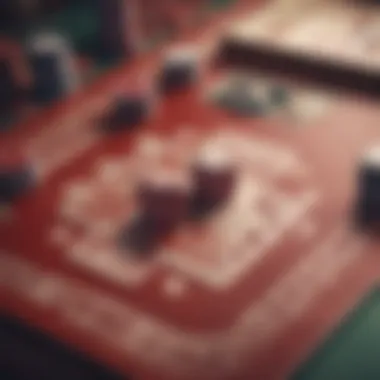Mastering Pai Gow Tiles: Strategies and History


Intro
In the realm of gambling, few games possess the depth and cultural resonance of Pai Gow tiles. Originating from ancient China, this tile-based game blends social interaction with strategic complexity, making it a captivating choice for players around the globe. The gameplay, deeply rooted in tradition, finds its way into modern casinos, where it offers not just a game of chance but also a test of skill and finesse.
As players embark on their journey to master Pai Gow tiles, understanding its rules, mechanics, and varying strategies becomes crucial. From the seasoned gambler to the casual player, everyone can glean insights from this intricate guide. In following sections, we'll peel back the layers of this fascinating game, right from its historical foundations to advanced tactics that can elevate one's gameplay.
Whether you’re drawn to the allure of the casino floor or the quiet thrill of a home game, Pai Gow tiles promises both engagement and excitement, where knowledge can significantly influence outcomes. So, let’s dive into the mechanics and strategies that encompass this unique game.
Prelude to Pai Gow Tiles
Pai Gow tiles carve out a unique niche in the landscape of casino games, offering gamblers not just entertainment but an intricate tapestry of history and strategy. Understanding Pai Gow goes beyond merely grasping the mechanics; it invites players into a world where tradition meets modern-day gameplay and strategy flourishes.
The importance of this introduction lies in establishing a firm foundation for the reader. Knowing the historical context and cultural significance of Pai Gow enriches the gameplay experience. It fosters a deeper appreciation for not just the rules and strategies involved, but also the social and cultural elements that have made this game endure through the ages.
Historical Overview
The roots of Pai Gow tiles trace back centuries to ancient China. Initially developed during the Song Dynasty, this game was an entertainment form for the Chinese elite. Cultural artifacts and early records illustrate how the game evolved over generations, transitioning from a casual pastime to a structured gambling game strategically played across the globe.
Modern-day Pai Gow is largely influenced by its predecessors, and the transition to casino gaming in the 20th century signaled a significant evolution. With adaptations from traditional Chinese gambling practices to the appealing format recognized in today’s casinos, Pai Gow has managed to weave itself into the fabric of global gambling culture. Players who sit down at a table are engaging not only with tiles and numbers but with history that speaks volumes about social interaction and leisure practices over centuries.
Cultural Significance
The cultural significance of Pai Gow tiles extends far beyond the gaming table. In Chinese society, tile games have historically symbolized unity and family bonding. This is evident from the gatherings where players come together, fostering connections while navigating the complexities of the game. Pai Gow is more than just a method of gambling; it's a ritual that celebrates friendships and family ties, especially during significant holidays like the Lunar New Year.
Furthermore, Pai Gow incorporates philosophical elements found in various aspects of Chinese culture, including balance and harmony, which resonate in the gameplay itself. For many players, the aim is not just about winning but about embracing the camaraderie found at the table.
"In Pai Gow, every player becomes part of a larger narrative, blending individual strategy with collective experience."
As players navigate the intricacies of tile arrangements and hand settings, they are engaging with a game steeped in cultural traditions and values. The worth of Pai Gow lies not just in the potential return on investment but in the enriching experience shared amongst participants.
Understanding these historical and cultural contexts is essential for any serious player. It enhances one’s approach to the game, guiding strategic decisions while simultaneously recognizing the communal and historical threads that connect us through this captivating form of entertainment.
Understanding Game Components
Understanding the game components of Pai Gow tiles is fundamentally important for any player aiming to enhance their gaming experience. It’s more than just knowing how the game flows; it's about grasping what each element contributes to your strategy and decision-making.
The Tiles
Tile Designs and Values
The intricate designs of Pai Gow tiles play a crucial role in gameplay. Each tile features distinct numbers which dictate their rank in the game. Traditionally, Pai Gow tiles have a total of 32 tiles, with designs that represent various numeric values ranging from 0 to 9 and pairs. The beauty of these tiles isn't just aesthetic. The specific values found on each tile often affect gameplay considerably. For instance, a tile showing an ace might have different implications than one with a seven. The unique feature lies in how these values shape your hand and how people perceive strength, often leading to better decision-making. This factor is critical in strategizing, as knowing tile values allows a player to set hands effectively.
Tile Groupings
Groupings of tiles also provide significant advantages in the game, specifically in understanding how to form stronger hands. Players group tiles in different configurations—typically pairs, triplets, or sequences. A key characteristic of tile groupings is their effect on play outcomes; a well-formed hand can be the difference between winning and losing. Grouping tiles means a player might maximize their strategic advantage during each round. Unique to this mechanic is how groupings blend the randomness of tile draw with the player's skill in adaptability. Therefore, knowing how to group tiles effectively can empower players to seize control of the game environment, giving them an edge over opponents.
Understanding Suits
Suits in Pai Gow tiles, while less pronounced than in card games, still carry significance. The suits are less about symbol recognition and more about grouping certain tiles with similar rankings. Understanding the suits and their arrangement can influence how you perceive opponents' hands. A key benefit here is knowing which tiles trump others based on the suits involved. Unique advantages to recognizing these patterns mean better skills in predicting opponents’ strategies. A disadvantage could be that some players may overlook this part of tile management, focusing only on ranks and pairs, thus missing potential winning opportunities.
The Setup
Playing Surface
The playing surface for Pai Gow adds another layer to the game. Usually, the table is specifically designed to accommodate the game's mechanics. A well-designed surface enhances gameplay by ensuring that each player’s tiles are easily visible to everyone at the table. The physical characteristics, such as size and layout, allow for strategic player positioning. A significant advantage lies in how different surfaces can affect tile handling and arrangement, making it easier or harder for players to maintain their focus and reduce distraction. A properly organized playing surface fosters a better atmosphere for strategic thinking and interaction among players.
Player Seating Arrangement
The arrangement of players around the table is pivotal to the game's flow and strategy. Traditionally, players sit facing one another, with the dealer positioned to moderate the play. A well-planned seating arrangement allows players to maintain an understanding of both the tiles in their hands and those of the opponents. This layout can highlight different player styles, shedding light on potential strategies within the game. The unique aspect of how seating impacts view and perception is noteworthy; an improper arrangement may lead to misjudging opponents’ strength or strategies. Moreover, it’s crucial to recognize that strong familiarity with seating can impact the overall gaming experience, affecting decision-making and the outcome of play.


Gameplay Mechanics
Understanding gameplay mechanics is pivotal for anyone aspiring to master Pai Gow tiles. This concept covers how the game operates, mechanisms that dictate player interaction, and rules that govern the flow of play. By having a solid grasp on these elements, players can make strategic decisions that may enhance their odds of winning. Not only does this understanding foster confidence, it also enables players to appreciate the complexity and beauty of the game.
Basic Rules
The foundation of Pai Gow rests on a set of basic rules that dictate how the game unfolds. Each player receives a set of tiles, usually consisting of 32 unique pieces. The primary aim is to create two hands, a high and a low, which beat the dealer's hands. Familiarity with the terminology used in Pai Gow is crucial, as it informs decisions made throughout the game. Knowing how to form pairs, doubles, and specific tile combinations can give players a distinct advantage.
Tile Arrangement and Scoring
Highs and Lows
The concept of highs and lows in Pai Gow tiles is fundamental in establishing score and strategies. High tiles consist of pairs or higher ranks, while low tiles typically represent lesser combinations. Understanding how to interpret these distinctions is what sets savvy players apart.
The key characteristic of the highs and lows lies in their ability to dictate the flow of the game. Since players can only win by having a stronger hand than the dealer, knowing how to effectively categorize tiles is beneficial.
Highs are popularly regarded as a winning strategy because with correct arrangement, they can significantly boost a player’s chances against the dealer. Nevertheless, it’s important to note that blindly focusing on highs without considering the low hand could lead to poor strategic choices, making balanced play essential.
"In Pai Gow, neglecting the low hand could see you lose a game you were positioned to win."
Setting the Hands
Setting the hands is another crucial element that involves determining how to split your tiles into two separate hands—one high and one low. This choice can greatly affect the outcome of each round. Players can choose between setting a strong high hand with weaker low hand, or a more balanced approach where both hands hold competitive strength.
The main advantage of setting hands thoughtfully is the flexibility it offers. Skilled players often manipulate their hands to exploit weaknesses in their opponents while safeguarding their own chances. However, opting for extremes in setting hands can backfire. A high hand may be too strong at the expense of a weak low hand, leaving a player vulnerable to defeat.
Turn Structure
Turn structure dictates the sequence in which players take their actions during the game. Understanding this structure means being aware of when to act based on the arrangement of tiles and the actions of others. In Pai Gow, taking one�’s turn can involve betting, setting hands, and ultimately revealing tile combinations against the dealer.
Players must be prepared to adapt their strategies based on not only their own hands but also the turn structure itself. This means that observations regarding opponents’ choices, especially during critical phases, can provide insight into their strategies.
As players navigate through the turn structure, timing becomes essential. Whether to play aggressively or defensively can rely heavily on current circumstances and the context of given hands.
The aforementioned mechanics are more than rules—they represent a framework for achieving success in Pai Gow tiles. Together, they create a rich tapestry of strategic possibilities that players must master to gain a competitive edge.
Strategic Approaches to Pai Gow
Strategic thinking is the backbone of success in Pai Gow. Unlike many card games where luck plays a significant role, Pai Gow involves a myriad of techniques that can enhance one’s chances of winning. Developing a deep understanding of strategic approaches not only sharpens individual gameplay but also brings a disciplined mindset to the table. By employing strategic methods, players can gain the upper hand over opponents, make informed decisions, and ultimately enjoy the game more.
Tile Selection
The art of tile selection is pivotal in Pai Gow. The right tiles can be the difference between crafting a winning combination and falling flat. Players must consider not just the values on the tiles, but also how these values can pair with others to elevate overall hand strength. Choosing tiles wisely means assessing the potential of each piece in tandem with the others currently in play.
Hand Setting Strategies
To navigate the complex landscape of Pai Gow effectively, hand setting strategies are crucial. Mastering the way tiles are arranged is fundamental to gameplay. It is central to creating competitive advantage.
Pairing Techniques
Pairing techniques involve the grouping of tiles in such a manner that maximizes the likelihood of favorable outcomes. Players assess their tiles to determine which should be combined and why. This method stands out for its adaptive nature. It allows players to adjust strategies based on the dynamics of the game at any moment.
One key characteristic of this technique is the balance between high-value tiles and lower-value ones. Prioritizing certain pairings can lead to a better overall score, making this an advantageous choice indeed. However, the unique feature of pairing techniques also lies in its complexities. Every decision can swing either way: a pairing that seems ideal may backfire against a clever opponent. Thus, precision and thought are paramount.
Optimal Pairing Logic
Optimal pairing logic revolves around the systematic evaluation of all possessions before them. Players weigh the pros and cons of every combination. This method encourages players to think critically about their options, helping them identify the path leading to higher payouts.
A fundamental characteristic is its logic-driven framework, providing a clear blueprint of actionable choices. This makes optimal pairing logic an essential strategy. The uniqueness of this approach lies in minimizing risk while maximizing potential gains. However, as with all strategies, it is not infallible. Misreading the setup can result in significant losses, proving that careful consideration is imperative.
Reading Opponents


One of the advanced strategies in Pai Gow is understanding one’s opponents. It entails analyzing their behavior and decisions to predict their moves. A solid grasp of reading players leads to a competitive edge.
Psychological Factors
Psychological factors play a substantial role in gaming dynamics. Observing how players react under pressure—whether they display confidence or uncertainty—can provide vital insights into their strategies. Focusing on their body language and decision-making patterns can shed light on what they might do next. Players who develop this skill often find themselves hitting the sweet spot between intuition and observation.
The characteristic of psychological awareness can significantly alter the outcomes in Pai Gow. By tapping into the mental states of opponents, one can anticipate actions and adjust strategies accordingly. However, this unique feature requires practice and patience; misinterpretation could lead to an unprofitable gamble.
Predicting Moves
Predicting moves stems from a combination of observing opponents and understanding the flow of the game. Players theorize the range of possible actions based on previous behavior, allowing for advanced preparation on their part. Players can gain an edge by capitalizing on habits and tendencies observed during gameplay.
This prediction ability is beneficial, as it effectively narrows down the choices available to opponents. A key element is the pragmatic anticipation of potential moves, paving the way for proactive responses rather than reactive ones. Yet, curating this skill necessitates time and diligence. Also, one must take into account that opponents may adapt and change their strategies, introducing an unpredictable dimension.
Understanding these strategies not only boosts a player’s chance of success but also enriches the experience of playing the game itself.
Common Variations of Pai Gow
The world of Pai Gow is as varied as the cultures from which it springs. Understanding the different variations is crucial for anyone looking to dive deeper into the game. Regional adaptations and unique house rules impact play styles and strategies, making the experience richer and more challenging. For players, being aware of these variations means they can adapt their approach and maximize their enjoyment.
Regional Differences
Regional variations of Pai Gow explain how the game morphs based on cultural influences and player preferences. In some places, the game is played with a different set of house rules that can alter gameplay significantly. For instance, in traditionally Chinese settings, Pai Gow tends to involve stricter adherence to classic rules, emphasizing hand strength and strategy over luck.
In contrast, Western adaptations often introduce more lenient regulations that permit additional betting options or unique scoring systems. This difference in style not only broadens the appeal of Pai Gow but also impacts how players formulate their strategies.
Consider the American version where card play and tile play might intertwine, attracting diverse players with different backgrounds. Likewise, you'll find in the Philippines, the game can be infused with local flavors that change how the tiles are valued and what combinations are prioritized.
Here are a few key regional variances to note:
- Traditional Chinese Pai Gow: Focuses heavily on the ranking of tiles and has rigid betting limits.
- American Pai Gow Poker: Merges poker elements with classic Pai Gow, opening up a myriad of betting strategies.
- Filipino Pai Gow: Might implement house specialty bonuses that are unique to local gaming environments.
As a player, understanding these distinctions equips one with relevant tactical insight, allowing for a more calculated approach to play.
House Rules
House rules in Pai Gow can sometimes be the wild card that defines the gaming experience. These rules can dictate everything from tile scoring to how ties are resolved, significantly changing a player’s approach. Understanding common house rules helps you navigate the nuances effectively.
Some notable examples of house rules are:
- Banker Position: In some games, the banker is rotated among players, whereas in others, it’s a fixed dealer-led position. This affects how players choose to bet and their strategy for tile arrangement.
- Commission Fees: In certain casinos, a commission is taken from winnings when a player beats the banker. Knowing if and how this applies affects player decisions on risk and reward.
- Wild Tiles: Some variations may allow certain tiles to play as wild cards, increasing the potential for high scoring hands. Understanding if your house follows such a rule can drastically shift a player's hand-setting approach.
The essence of Pai Gow lies not just in the mastery of the tiles but in the artistry of adapting to the rules at hand.
In summary, having an awareness of regional differences and house rules can be a game-changer. They prepare players to adapt their strategies on the fly, allowing for a more fluid gaming experience that respects both tradition and modern flair.
Exploring Online Pai Gow
In the digital age, the evolution of traditional games has paved the way for a new realm of interaction and experience. Exploring online Pai Gow has become a significant aspect of understanding its gameplay and appeal. This transition from physical tables to online platforms offers fresh perspectives and benefits that can enrich the player's journey.
Digital Platforms
Digital platforms for Pai Gow essentially create a bridge between traditional gameplay and virtual interaction. They not only mimic the real-world experience but also introduce unique features that can enhance understanding and enjoyment of the game.
Game Mechanics Online
When discussing game mechanics online, one must recognize that it captures the very essence of Pai Gow while presenting it in an accessible format. One striking feature is the automation of dealing and scoring tiles. This technology eliminates possible misunderstandings that can occur in real-life settings.
Key characteristic: The ability to play with real-time opponents or against sophisticated algorithms adds a layer of flexibility for users.


- Benefits: Players can take advantage of tutorials and simulations, providing an opportunity to practice without financial risk. Additionally, many platforms allow players to customize their gaming parameters, from the number of opponents to the speed of play.
- Considerations: However, some players might miss the social aspects of face-to-face interaction, where body language and bluffs play a vital role.
User Experience
User experience is at the heart of engaging players and determining the success of online Pai Gow. The design of interfaces must be intuitive and visually appealing, drawing players into the virtual tables with ease.
Key characteristic: Outstanding user experience often manifests in smooth navigation and responsive gameplay, reducing the frustration that sometimes accompanies online gaming.
- Unique feature: Many new platforms incorporate community features, such as chat options and leaderboards, which can help mimic social dynamics akin to traditional casinos.
- Advantages/Disadvantages: While these elements can enhance camaraderie, they might be distracting to some players who prefer a focus on strategy.
Comparative Analysis to Traditional Play
When comparing online Pai Gow to traditional play, several differences emerge that potential players should acknowledge. The ambiance of a bustling casino can be invigorating, but online platforms deliver advantages that warrant consideration.
- Accessibility: Online options are available at any time, removing the constraints of physical location and operational hours. This level of access can be especially beneficial for players looking to refine their skills regardless of their geographic location.
- Variety of options: Online platforms can provide an array of game types, variations, and stakes that might not be available in every casino. This diversity ensures that players can continuously explore new strategies and challenges.
- Cost: Online play often proves to be more cost-effective, as many sites offer free versions of the game or lower stakes, enabling players to engage with less financial pressure.
Exploring online Pai Gow offers a multifaceted experience, merging the complexity and strategy of the game with the conveniences and innovations of digital technology. By navigating this landscape, players can gain strategic insights, refine their skills, and ultimately elevate their appreciation for the game.
Responsible Gaming Practices
Responsible gaming practices serve as a fundamental pillar for players diving into Pai Gow tiles. Understanding the nuances of this principle not only enhances the overall experience but also safeguards one’s emotional and financial well-being. Engaging in Pai Gow can be thrilling, but it also carries with it the potential risks of excessive gambling. Hence, implementing responsible practices is paramount.
Understanding Limits
First and foremost, understanding one’s limits is essential. Players should set clear boundaries regarding time and money. For instance, decide on the amount of money you are willing to invest, and once you reach that limit, it's time to step away. This self-imposed boundary helps prevent chasing losses and keeps the enjoyment intact.
Additionally, keeping track of time is equally crucial. It’s all too easy to lose track while swept up in the excitement of tiles clattering and hands setting. Consider using timers or alerts on your phone to remind you to take breaks or signal the end of your gaming session. Here are some practical strategies:
- Budgeting your bankroll: Allocate a specific budget for your gaming sessions.
- Time management: Set clear start and end times for your sessions.
- Self-assessment: Regularly reflect on your emotions and responses during gameplay.
Recognizing Problematic Behavior
Next comes the importance of recognizing problematic behavior. Gambling can become problematic when fun morphs into compulsion. Being aware of signs such as persistent preoccupation with gambling, increasing amounts of time spent playing, and neglecting personal responsibilities can be indicative of a deeper issue.
It's worth noting that many gamblers might dismiss these signs, attributing them to a mere passion for the game. On the contrary, acknowledging these signs early on can be a life-saver. Regular self-evaluation can be beneficial. Ask yourself:
- Am I gambling to escape other problems?
- Do I feel anxious about gambling?
- Am I lying about my gambling habits to friends or family?
Recognizing these factors can set players on a healthier path and foster a more constructive relationship with the game. Ultimately, by prioritizing responsible gaming practices, each player contributes not just to their own wellbeing but to the community at large, advocating an environment where everyone can enjoy this fascinating game with peace of mind.
"Responsible gaming is not just a choice; it's a lifestyle that ensures the enjoyment of games like Pai Gow stays uplifting and fun."
By promoting these principles, players can ensure that their experience is as rewarding and enjoyable as possible.
Finale
The conclusion of this guide holds critical weight as it synthesizes the vast terrain we just traversed in the world of Pai Gow tiles. It offers readers an opportunity to consolidate their learning and appreciate the profound effects of strategic thinking and cultural relevance inherent in the game.
Engaging in Pai Gow isn’t just about luck; it’s about understanding the intricacies of tile arrangements and rules which, as discussed, play a pivotal role in turning the tides of fortune. With vibrant historical roots and a unique blending of skill and chance, Pai Gow stands as more than just a gambling pursuit. It embodies a rich tapestry of cultural significance that connects players to a tradition steeped in community and legacy.
Moreover, employing the strategies outlined throughout this guide can elevate a player’s experience from mere participation to a more profound engagement with the game. Whether you aspire to master the nuances of hand settings, delve into the psychology of opponents, or comprehend the variations across different play styles, the insights provided offer a thorough grounding.
As you step into a gameplay environment—whether at a casino or online—remember that the essence of Pai Gow tiles extends beyond winning or losing. It’s about crafting connections, enjoying the challenge, and appreciating the layers beneath the surface.
"The best victories are not just about the score; they are about the journey and the lessons learned along the way."
By taking the time to deepen your understanding of Pai Gow tiles, you unlock a realm where skill meets strategy, and enjoyment is amplified, ensuring that every hand dealt is approached with newfound wisdom. The harmony of tradition and modernity in Pai Gow tiles awaits; dive in courageously and let your journey begin!
Final Thoughts
In closing, this guide served not merely as a roadmap, but as an invitation—to embrace the art of Pai Gow tiles fully. The game is an intricate dance of strategy and chance, which can only be mastered through experience and reflection.
We’ve explored essential elements from the historical backdrop to gameplay strategies—the whole works that shape this compelling game. Whether you’re a seasoned gambler or just taking your first steps, the insights shared within this article are meant to bolster your confidence and deepen your understanding.
It's strongly advisable to approach each session with calculated caution. Keeping a check on your limits, as previously discussed, ensures that enjoyment remains intact. The thrill of skilled play, combined with the camaraderie of fellow players, creates an enriching environment, uniquely tied to the fascinating realm of Pai Gow tiles.
Thus, as you leave this guide, carry with you not just facts but an appreciation for a game that offers a comprehensive blend of art, strategy, and tradition.















